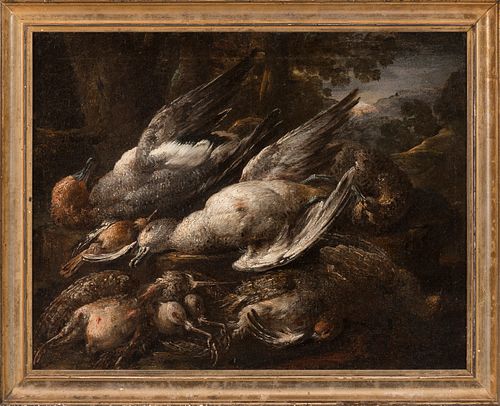Italian school; 17th century. "Still life of birds". Oil on canvas. Relined
Lot 48
About Seller
Setdart Auction House
Carrer Aragó 346
Barcelona
Spain
Setdart Subastas was born in 2004 and is currently the first online art auction in Spain with solidity, prestige and reliability guaranteed by our more than 60,000 users. Setdart has a young, dynamic and enterprising team ready to successfully manage the purchase and sale of art works through custom...Read more
Estimate:
EUR€2,700 - EUR€3,000
$2,903.23 - $3,225.81
Absentee vs Live bid
Two ways to bid:
- Leave a max absentee bid and the platform will bid on your behalf up to your maximum bid during the live auction.
- Bid live during the auction and your bids will be submitted real-time to the auctioneer.
Bid Increments
| Price | Bid Increment |
|---|---|
| EUR€0 | EUR€10 |
| EUR€200 | EUR€25 |
| EUR€500 | EUR€50 |
| EUR€1,000 | EUR€100 |
| EUR€3,000 | EUR€200 |
| EUR€5,000 | EUR€500 |
| EUR€10,000 | EUR€1,000 |
| EUR€20,000 | EUR€2,000 |
| EUR€50,000 | EUR€5,000 |
About Auction
By Setdart Auction House
Oct 20, 2021
Set Reminder
2021-10-20 07:30:00
2021-10-20 07:30:00
America/New_York
Bidsquare
Bidsquare : OLD MASTERS
https://www.bidsquare.com/auctions/setdart-auction-house/old-masters-7700
Setdart Auction House sofia@setdart.com
Setdart Auction House sofia@setdart.com
- Lot Description
Italian school; 17th century. "Still life of birds". Oil on canvas. Relined Presents repainting and frame of the nineteenth century. Size: 53,5 x 68,5 cm; 62 x 77,5 cm (frame). This oil painting denotes a high technical skill, determined by a vigorous drawing, endowed with great expressiveness, together with the ability to create a typically baroque tension, through intense light contrasts, features that converge in this scene where every detail is reproduced with great plasticity, showing the right tactile quality: the tousled feathers of partridges, the plush texture of the duck, etc.. The animals seem to pulsate to a rhythm that transcends the boundary between life and death. Being the Golden Age for still life painting, we are before an exponent of the ability to transfer the dynamic flavor of the Baroque to the still life genre, traditionally characterized by portraying inert objects. During the 17th century, there was a growing demand for paintings to decorate the homes of the bourgeoisie. Apart from portraits and large canvases with religious, historical or mythological themes, artists specialized, painting medium-sized works that gradually increased in format, with still lifes, animals, landscapes and genre scenes. The paintings that reproduce collectors' cabinets of the time are explicit in this respect, to the point of originating a new autonomous pictorial genre. Undoubtedly, the future of this painting would have been different without Rubens, whose art revolutionized the artistic panorama of Europe, introducing a new fully baroque way and bringing a sense of unity and opulent sumptuousness to the orderly and encyclopedic sample that were the precious descriptions of his countrymen. Debtors of his manner or subordinate to his work, the specialists worked in a new line, adding to their compositions an accessory object, a landscape or a decorative background. In this piece the luminous aspect stands out, on the other hand, it is key in this work, and reveals the direct influence of the tenebrist baroque, which reached these still life painters and lasted until well into the 18th century.
- Shipping Info
-
In-house shipping available. Please inquire at admin@setdart.com.
-
- Buyer's Premium



 EUR
EUR CAD
CAD AUD
AUD GBP
GBP MXN
MXN HKD
HKD CNY
CNY MYR
MYR SEK
SEK SGD
SGD CHF
CHF THB
THB








